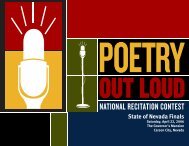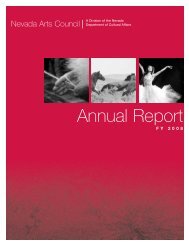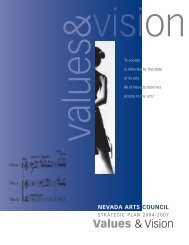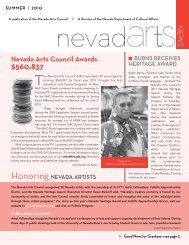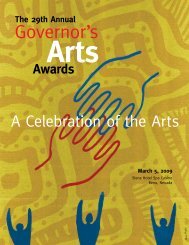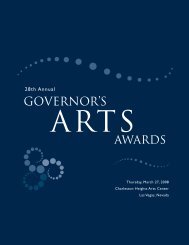Public Art - Nevada Arts Council
Public Art - Nevada Arts Council
Public Art - Nevada Arts Council
Create successful ePaper yourself
Turn your PDF publications into a flip-book with our unique Google optimized e-Paper software.
March 2004 | Monograph | 13<br />
Survey Highlights: Visual <strong>Art</strong>ist Rights Act<br />
The Visual <strong>Art</strong>ist Rights Act of 1990 (VARA) is Section<br />
106A of the copyright law. It applies to any work<br />
created after 1990. VARA establishes a definition of<br />
visual art, which includes sculpture. VARA provides<br />
protection beyond the economic rights of the<br />
copyright law, and is distinct from ownership of a copy<br />
of an artwork or of a copyright or any exclusive right<br />
under copyright to that artwork.<br />
VARA is personal to the artist, its protection is for<br />
the life of the artist, and an artist’s VARA rights cannot<br />
be transferred. VARA provides for the artist’s right of<br />
attribution to claim authorship of his or her work; to<br />
prevent the use of his or her name on any work he or<br />
she did not create; and to have his or her name<br />
removed from any work that is distorted, mutilated,<br />
or modified that would reflect with prejudice on the<br />
artist’s reputation.<br />
VARA provides for the artist’s right of integrity to prevent<br />
any intentional distortion, alteration, or destruction of a<br />
work of recognized stature, and any intentional or grossly<br />
negligent destruction of a work in violation of that right.<br />
The artist can waive his or her VARA rights, but a waiver<br />
has to be in writing and must specifically identify the<br />
artwork and the uses of that artwork. The waiver applies<br />
only to the artwork and uses so identified.<br />
Eighty-eight percent of responding public art programs<br />
report that their artist contract complies with VARA.<br />
Similarly, 90 percent of public art programs say that<br />
the artists that they commission retain the copyright of<br />
their work. When the copyright is not maintained by<br />
the artists, most often it becomes the property of the<br />
public art program. A few programs report that they<br />
share a joint copyright with the artists.<br />
Definition by William Gignilliat, Esq., PAN <strong>Council</strong><br />
committee member.<br />
The dispute kept the project on hold for<br />
months, until a revised installation was approved<br />
for completion.<br />
Everyone’s a critic. If you want to find fault<br />
with a public art project at any point in the<br />
process, you can. And, depending on the<br />
situation, there may be a need for “damage<br />
control.” Obtaining written support from key<br />
community leaders and project stakeholders<br />
early on can help.<br />
Strategic planning and obtaining early feedback<br />
helps avoid unwanted controversy. Play your<br />
own devil’s advocate and determine the risks<br />
carefully, then move forward with assurance and<br />
conviction. If you consider the examples listed<br />
here—all considered great works of public art—<br />
controversy can be viewed as a good sign.<br />
Controversy and an abundance of attention<br />
indicate that people are interested, concerned,<br />
or even outraged. This begs the question: why?<br />
The root of this question is at the heart of what<br />
makes public art so compelling.<br />
Serving Communities. Enriching Lives.



